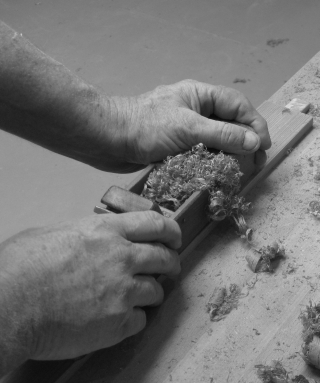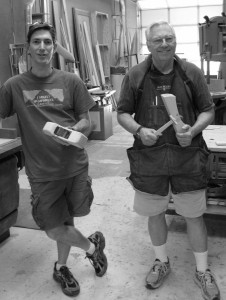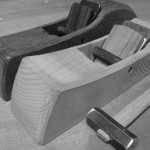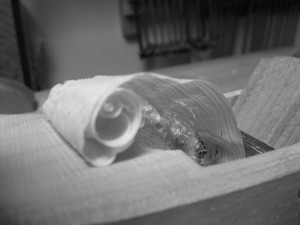 Making and using wooden hand planes are among my favorite things to do, so I was pleased when Phil Groben and Ryan Edwards chose to make planes with me in the April 23-24 session. Understanding the critical points of plane making and use allows you the flexibility to make planes of all kinds, for ‘normal’ use and special purposes. It also informs the process of tuning up and using metal planes — the principles are pretty much the same.
Making and using wooden hand planes are among my favorite things to do, so I was pleased when Phil Groben and Ryan Edwards chose to make planes with me in the April 23-24 session. Understanding the critical points of plane making and use allows you the flexibility to make planes of all kinds, for ‘normal’ use and special purposes. It also informs the process of tuning up and using metal planes — the principles are pretty much the same.
 People often ask me, “Why wooden planes?” as opposed to steel or iron. True, both types can be make equally fine cuts — and more than a few folks would argue that steel planes are easier to adjust, generally, than their wooden brethren. Well … perhaps.
People often ask me, “Why wooden planes?” as opposed to steel or iron. True, both types can be make equally fine cuts — and more than a few folks would argue that steel planes are easier to adjust, generally, than their wooden brethren. Well … perhaps.
 Jim Krenov used to talk about the wooden plane as an instrument, as sensitive in the hands of a craftsman as a fine violin in the hands of a master musician, and I agree with him. You can hold it and use it in ways impossible (or at least awkward and uncomfortable) with a standard metal plane. It responds to changes in pressure as you use it, and with your hands wrapped around the body the process of planing wood becomes more of a sensory experience (I would go so far as to say ‘sensual’).
Jim Krenov used to talk about the wooden plane as an instrument, as sensitive in the hands of a craftsman as a fine violin in the hands of a master musician, and I agree with him. You can hold it and use it in ways impossible (or at least awkward and uncomfortable) with a standard metal plane. It responds to changes in pressure as you use it, and with your hands wrapped around the body the process of planing wood becomes more of a sensory experience (I would go so far as to say ‘sensual’).
Making a smoothing plane from start to finish in your own shop should take about a day, from start to finish. It fills up all of two days in class, and that’s starting with pre-milled body blanks so that we can skip some of the grunt work. There is still plenty to do: aligning the parts properly and doweling them, locating and making the cross pin, and gluing up the blank; grinding, honing and polishing the plane iron and mating it to the chip breaker; cleaning up the body once it’s out of the clamps, fitting a temporary wedge and flattening the bottom of the plane; carefully opening the mouth with a file; making and fitting the permanent wedge; shaping the plane and, of course, making fine adjustments to the wedge and mouth until all is in harmony and the plane is able to take an incredibly fine shaving from a piece of hard maple.
We also make a small plane adjusting hammer, using a 3.5oz piece of turned and milled brass for the head and shaping and fitting an appropriate handle from ash.
There’s nothing quite like the feeling you get the moment that first shaving exits the throat of a new plane, made with your own hands. I hope you’ll consider joining me for a plane making session in the future.



